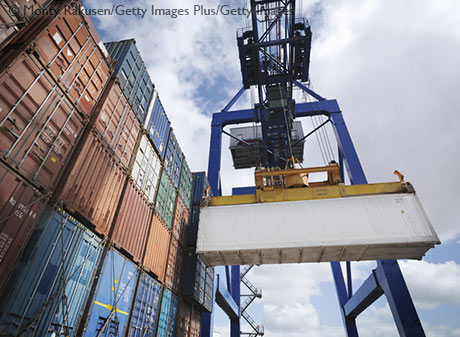The Role of Innovations in Global Trade: The Shipping Container

This is the first post in a two-part series on the role of innovations in global trade.
Technological and organizational innovations have played significant roles in expanding global trade throughout history. A simple innovation—the use of shipping containers—may have contributed to the rapid expansion of global trade over the past 50 years, according to a recent Regional Economist article.
“We argue that the stunning growth in trade volumes and the spreading out of production and supply chains are both closely associated with the development of a global trade network based on the use of containers,” wrote Alexander Monge-Naranjo, an economist and research officer, and Qiuhan Sun, a research associate.
This post examines the impact of containerization on global trade. The next post will focus on the potential impact of another innovation—information and communication technologies (ICT).
Rapid Expansion of International Trade
The authors noted that from 1970 to 2018:
- Total world exports increased more than 65 times (from $384 billion to $25 trillion); after adjusting for inflation, total exports have still grown tenfold.
- The fraction of internationally traded goods and services worldwide increased from less than 14% of global GDP to more than 30%.
- For the U.S., the ratio of exports to GDP went from 5.6% to 12.2%.
A key factor spurring this rapid globalization was the pervasive adoption of containers and corresponding infrastructure, which led to drastic cost reductions for transporting goods.
How the Use of Containers Affects Trade
“Obviously, a vast and complex network of ports and logistics capabilities had to be developed to exploit the possibilities afforded by containerized and intermodal transportation,” the authors wrote.
They explained that the diffusion and adoption started in the 1970s and accelerated during the 1980s and 1990s, which led to the economies of scale and of scope needed to achieve substantial gains in productivity and lower costs.
Today, all major ports are integrated into a global maritime transport system, Monge-Naranjo and Sun noted.
“This has led to drastic reductions of one, two and possibly three orders of magnitude in the transportation costs for most goods,” they wrote.
The Effects on the U.S. Trade Balance
The authors looked at two broad periods in the postwar history of U.S. trade balances:
- The end of World War II to the late 1970s
- The early 1980s to the present
During the first period, the U.S. was the major global producer of manufactures and had a positive trade balance, the authors noted. But since the early 1980s, when the U.S. became a net importer of manufactures, the country has had sustained and persistently growing trade deficits.
With the dissemination of shipping containers and the resulting expansion of trading networks, producers can consider new sites and tap lower-cost labor typically found in developing countries, the authors explained. Shifting production to these new sites displaces some production centers, including those in the U.S.
As a result, the authors noted, foreign competition in manufactures has been linked to the trade deficits in the U.S. since the 1980s and to the acceleration of the ongoing contraction in U.S. manufacturing employment.
Conclusion
“At the root of it, this global reorganization of production is a simple idea (the container) without which geography would still be bonding the location of production to that of consumption,” the authors wrote.
With the diffusion of containerization also comes a complex adoption of logistics and ICT, they noted. The next post will discuss the possibility that the diffusion of ICT may turn the U.S. trade deficit back into a surplus.
Additional Resources
- Regional Economist: Will Tech Improvements for Trading Services Switch the U.S. into a Net Exporter?
- Regional Economist: How Industrialization Shaped America’s Trade Balance
- Timely Topics: Educated Workers and America’s Competitiveness
Citation
ldquoThe Role of Innovations in Global Trade: The Shipping Container,rdquo St. Louis Fed On the Economy, Dec. 28, 2020.
This blog offers commentary, analysis and data from our economists and experts. Views expressed are not necessarily those of the St. Louis Fed or Federal Reserve System.
Email Us
All other blog-related questions

